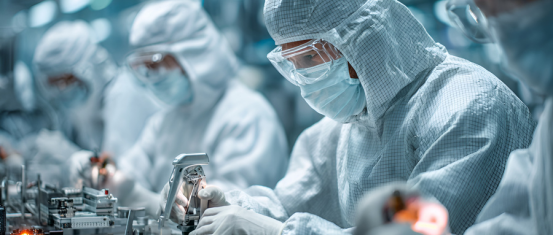In the tide of global industrial transformation, high-end equipment manufacturing, as the core carrier of national strategic industries, is undergoing the dual drive of technological iteration and industrial upgrading.

Image Source:699pic
Technological Integration: A Paradigm Revolution from Single Equipment to Intelligent Systems
The wave of intelligence is reshaping the technological paradigm of high-end equipment manufacturing with overwhelming force. The penetration rate of industrial internet platforms has crossed the critical point, and technologies such as AI quality inspection and digital twins have been deeply integrated into production processes, promoting the transition of equipment from "function realization" to "intelligent decision-making". Smart factories realize equipment interconnection and data sharing through IoT technology. Predictive maintenance systems reduce equipment failure rates by more than 40%, and the Overall Equipment Effectiveness (OEE) has been raised to the internationally leading level of 85%. Flexible production lines support mixed-flow production of multiple product categories, with the changeover time reduced from hours in the traditional mode to minutes, accurately meeting the rapid iteration needs of industries such as consumer electronics and auto parts.
The depth of technological integration goes far beyond the level of single equipment. In the aerospace field, five-axis machining centers achieve micron-level processing of aero-engine blades through dynamic accuracy compensation technology, supporting the commercial operation of the domestic large aircraft C919; in the rail transit field, intelligent power supply systems optimize energy distribution with big data analysis, reducing line loss by 15%, and the commercial operation of hydrogen energy trams opens up a new paradigm of zero-emission transportation; in the marine engineering field, deep-sea drilling platforms integrate new anti-corrosion materials and energy-saving systems, extending equipment life to more than 20 years and reducing operating costs by 25%. These breakthroughs mark that high-end equipment manufacturing is evolving from "single-machine intelligence" to "system intelligence", building an industrial ecology with self-perception and self-decision-making capabilities.
Green Transformation: Ecological Reconstruction from Energy Consumption Control to Full Life Cycle
Greenization has become a survival rule for the industry's development. At the policy level, documents such as the "Opinions on Promoting the High-Quality Development of Environmental Protection Equipment Manufacturing Industry" promote the in-depth integration of the industry towards "greenization, digitalization, intelligence and high-endization", requiring enterprises to establish a full-life-cycle carbon footprint tracking system. At the technical level, technologies such as clean energy substitution, pollutant emission reduction and resource recycling are accelerating their penetration: in the wind power equipment field, the single-unit capacity of offshore wind turbines has exceeded 20MW, and the supporting deep-sea cable technology has realized stable transmission, supporting the coordinated development of "domestic offshore wind power + overseas markets"; additive manufacturing technology has been applied on a large scale in the manufacturing of complex structural parts such as aero-engine blades and medical implants, with material utilization rate increased from 15% in traditional processes to more than 90%; in the shipbuilding field, the proportion of LNG-powered ship orders has exceeded 30%, and the supporting carbon capture system has realized carbon dioxide emission reduction during navigation.
The deep logic of green transformation lies in the innovation of business models. Environmental protection equipment enterprises have incorporated value-added services such as remote operation and maintenance and predictive maintenance into contracts through the "product + service" model, with service revenue accounting for 40%; rail transit equipment manufacturers have launched "energy efficiency trusteeship" services to help customers reduce operating costs through intelligent scheduling systems, forming long-term revenue streams; marine engineering enterprises have built "equipment leasing + data service" platforms, transforming deep-sea drilling platforms into data collection terminals and opening up new profit growth points. This transformation not only meets the requirements of the "dual carbon" goals but also reconstructs the value creation logic of the industry.
Global Competition and Cooperation: Strategic Upgrade from Technology Introduction to Standard Output
Global competition has forced the industry to accelerate ecological collaboration. Leading enterprises have built technical barriers through merger integration and strategic alliances. For example, after acquiring an international industrial robot giant, an enterprise formed a collaborative model of "German technology + Chinese manufacturing", reducing product costs by 20% while increasing production capacity by 50%; the regional cluster effect enhances the resilience of the industrial chain through vertical integration and modular division of labor. Suzhou Industrial Park has gathered many robot enterprises, forming a complete industrial chain from reducers and servo motors to system integration, with a local supporting rate of over 80%.
Promoted by the "Belt and Road" Initiative, "national heavyweight equipment" such as rail transit equipment and marine engineering equipment are accelerating their overseas expansion. China's high-speed rail technical standards have been incorporated into the railway construction specifications of many countries, and deep-sea drilling platforms have been exported to many countries and regions; in the fields of high-end CNC machine tools and industrial software, enterprises have enhanced their discourse power by participating in the formulation of international standards. A domestic CAD/CAM system has achieved independent control, breaking foreign monopoly, and its target market share continues to rise. This "hard technology + soft standard" output model has promoted China's transformation from a participant in the global value chain to a rule-maker.
- pre:Technological breakthroughs in chemical equipment
- next:Heavy equipment creates the industrial glory of a great country
Please click to consult us immediately or call the hotline: 4006-979-616We will solve the problems in your heart in detail。Online consultation



 Online Service
Online Service
